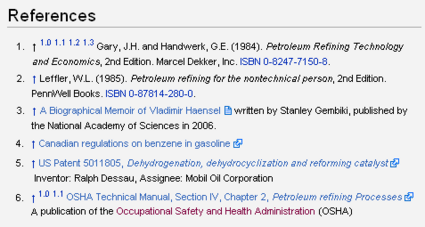User:Milton Beychok/Sandbox
| This is a Citizendium help page |
| This help page is meant for help and guidance only. It can be edited by any Citizen and, whilst we try to ensure it is accurate, it may not fully represent current policy. |
| Further guidance can be found at the How to edit an article page. |
An External link in the Citizendium website is a hyperlink[1] pointing to a specific resource (e.g., a page or document) in some other online website. Clicking on an external link connects you to that resource. Formatting an external link to a resource in another website is done by enclosing the URL[2] of the resource in brackets and including an appropriate title for the resource. The title must be separated from the URL by a single space. Thus, the format coding is simply [URL title].
For example, placing [http://www.epa.gov/aboutepa/organization.html EPA Organizational Structure] on the edit page of any article or any talk page will result in EPA Organizational Structure being displayed as a blue link in the article or talk page. Clicking on that blue link will take you to that resource on the website of the U.S. EPA.
Note that the URL in the above example is http://www.epa.gov/aboutepa/organization.html and the resource title is EPA Organizational Structure, and they are separated by a single blank space. Except in some special circumstances, a bare URL (without an appropriate title) should not be used as an external link.
The difference between external and internal links
As explained above, an external link points to a resource on some other website. An internal link is a hyperlink that points to a resource located elsewhere in Citizendium and is often referred to as a wiki link. Internal links are formatted differently than external links (see Help:Index/Formatting/Links/Internal for how to format internal links.) For example, the blue U.S. EPA link in the above introductory section is an internal link that take you an article elsewhere in Citizendium.
Using external links as embedded, inline references
External links may be used as embedded, inline references or footnotes as explained in much more detail at Help:Index/Formatting/References. Embedded inline references are references that corroborate a specific word, statement, paragraph or even sub-section of an article by providing the readers of the article with the details of a book, journal, newspaper report or online website page that substantiates and validates the word, statement, paragraph or sub-section.
The adjacent Figure 1 illustrates how external links used as embedded, inline references are displayed on the "References" section at the end of Citizendium articles.
As an example of an external link used as an embedded, inline reference, placing this on the edit page of an article at its proper point of insertion:
- <ref>[http://www.nap.edu/openbook.php?record_id=11807&page=175 A Biographical Memoir of Vladimir Haensel] written by Stanley Gembiki, published by the National Academy of Sciences in 2006.</ref>
produces reference 3 as displayed in the example "References" section depicted in Figure 1. Note that the above formatting first has a <ref> tag, followed by the external link enclosed by square brackets and then followed by some brief annotation (the author's name, the publishing entity and the date) and finally ends with a closing </ref> tag. Also note that the external link enclosed in square brackets includes the URL of the resource reference, followed by a single blank space and then the title "A Biographical Memoir of Vladimir Haensel", just as discussed above in the introductory section.
As another example, placing this on the edit page of an article at its proper point of insertion:
"External Links" subpages
External links that are not used as corroboration for some part of an article, but do contain interesting material relative to an article in general, are placed in the "External Links" subpage of the article.
For example,
The adjacent Figure 2 illustrates how how external links are displayed when stored in an "External Links" subpage.
Annotation of external links
Footnotes
| Click here to return to main help page. |
| Citizens, we need your help! |
| These help pages are a work in progress and need developing. Some topics are not written at all yet. Feel free to edit this page, or any other within the help system, and contribute towards making this a useful tool to all. |

